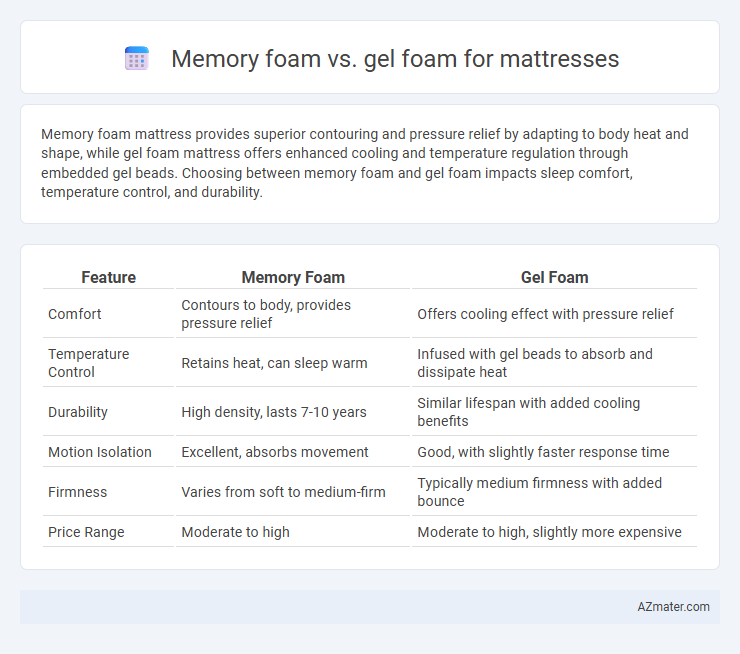Memory foam mattress provides superior contouring and pressure relief by adapting to body heat and shape, while gel foam mattress offers enhanced cooling and temperature regulation through embedded gel beads. Choosing between memory foam and gel foam impacts sleep comfort, temperature control, and durability.
Table of Comparison
| Feature | Memory Foam | Gel Foam |
|---|---|---|
| Comfort | Contours to body, provides pressure relief | Offers cooling effect with pressure relief |
| Temperature Control | Retains heat, can sleep warm | Infused with gel beads to absorb and dissipate heat |
| Durability | High density, lasts 7-10 years | Similar lifespan with added cooling benefits |
| Motion Isolation | Excellent, absorbs movement | Good, with slightly faster response time |
| Firmness | Varies from soft to medium-firm | Typically medium firmness with added bounce |
| Price Range | Moderate to high | Moderate to high, slightly more expensive |
Introduction to Memory Foam and Gel Foam Mattresses
Memory foam mattresses are made from viscoelastic polyurethane, providing superior contouring and pressure relief by molding to the body's shape and distributing weight evenly. Gel foam mattresses incorporate gel particles or beads within the memory foam, enhancing cooling properties by dissipating heat more effectively for improved temperature regulation. Both materials offer unique benefits for comfort and support, with memory foam excelling in body conformity and gel foam targeting temperature control for a cooler sleep experience.
What is Memory Foam?
Memory foam is a viscoelastic polyurethane material designed to conform to the body's shape by responding to heat and pressure, offering personalized support and pressure relief. It helps distribute body weight evenly, reducing stress on joints and enhancing comfort for sleepers. Commonly used in mattresses, memory foam is known for its contouring ability and motion isolation properties, making it ideal for individuals seeking customized support and minimal disturbance during sleep.
What is Gel Foam?
Gel foam is a type of memory foam infused with gel beads or swirls designed to enhance temperature regulation by dissipating body heat more effectively than traditional memory foam. This infusion provides a cooler sleep surface while maintaining pressure relief and contouring support characteristic of memory foam mattresses. Gel foam mattresses are ideal for hot sleepers seeking comfort without overheating during the night.
Key Differences Between Memory Foam and Gel Foam
Memory foam mattresses contour closely to the body by responding to heat and pressure, promoting spinal alignment and pressure relief, while gel foam incorporates cooling gel particles or layers to enhance breathability and temperature regulation. Memory foam tends to retain heat more, making it less suitable for hot sleepers, whereas gel foam mattress options provide improved airflow and dissipate body heat effectively. Durability varies as memory foam can soften over time, but gel foam often maintains consistent support and cooling properties longer.
Comfort and Support Comparison
Memory foam mattresses conform closely to the body's shape, providing exceptional pressure relief and personalized comfort by evenly distributing weight. Gel foam mattresses enhance traditional memory foam by incorporating cooling gel beads or layers, which help regulate temperature and prevent heat retention for a cooler sleep experience. Both offer excellent support, but gel foam's temperature regulation can improve overall comfort for sleepers prone to overheating.
Temperature Regulation: Which Sleeps Cooler?
Gel foam mattresses outperform traditional memory foam in temperature regulation due to infused cooling gel beads that dissipate heat efficiently. Memory foam tends to retain body heat, leading to warmer sleep conditions, whereas gel foam enhances airflow and provides a cooler sleep surface. Choosing gel foam can significantly reduce overheating and improve overall sleep comfort for hot sleepers.
Durability and Longevity
Memory foam mattresses typically offer excellent durability due to their dense structure, allowing them to retain shape and support for 7 to 10 years. Gel foam mattresses incorporate cooling gel beads within the foam to enhance temperature regulation without significantly compromising the material's lifespan, which generally matches that of traditional memory foam. Both options maintain longevity when high-density foams are used, but gel-infused varieties tend to reduce heat retention, potentially contributing to more consistent performance over time.
Pros and Cons of Memory Foam
Memory foam mattresses offer excellent contouring and pressure relief by conforming closely to the body's shape, making them ideal for individuals with joint pain or spinal issues. However, memory foam tends to retain heat, which can cause discomfort for those who sleep hot, and its dense structure sometimes results in slower responsiveness and a sinking sensation. Despite these drawbacks, memory foam's durability and motion isolation capabilities make it a popular choice for minimizing sleep disturbances.
Pros and Cons of Gel Foam
Gel foam mattresses offer superior temperature regulation by dispersing heat more effectively than traditional memory foam, making them ideal for hot sleepers. They provide the contouring support and pressure relief benefits of memory foam while enhancing breathability to reduce night sweats. However, gel foam can sometimes be less durable than high-density memory foam, leading to potential sagging over time.
Which Mattress is Right for You?
Memory foam mattresses excel in contouring to body shape and providing pressure relief, ideal for those seeking deep support and motion isolation. Gel foam mattresses offer enhanced temperature regulation with a cooler sleep surface, making them suitable for hot sleepers or individuals prone to night sweats. Choosing the right mattress depends on your priority between comfort customization and thermal comfort to ensure optimal sleep quality.

Infographic: Memory foam vs Gel foam for Mattress
 azmater.com
azmater.com